
Goldfish Care Guide
The latest advice for goldfish owners
If you’re new to keeping goldfish or want to refresh your knowledge, you’ve come to the right place! In this introduction to goldfish care, we give you the best and most up-to-date advice on how to care for goldfish and help them live a long time.
Our guide to goldfish care is constantly kept up-to-date and covers:
- Your goldfish tank: What size tank you need to care for goldfish properly and how many fish you can keep together
- Goldfish care equipment: What equipment you need to take good care of goldfish and the latest products on offer
- Goldfish food: How to feed your goldfish a nutritious and healthy diet
- Water parameters and water changes: When and how to change your goldfish tank water as part of a good goldfish care routine
- Health: How to stop your goldfish getting sick
The aim of this introduction to goldfish care is to give beginners the basic knowledge they need to care for goldfish properly. Of course, there’s much more to learn about goldfish, so throughout this care guide you’ll find links to other articles that explore these topics in more detail.
The Goldfish Tank has been offering expert goldfish care advice since 2013 and is written, updated and maintained by a knowledgeable team of aquarists. If you need more help or you’re unsure about anything in this guide, please get in touch or add a comment below.
What size tank do goldfish need?
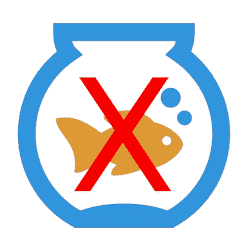
The most important part of proper goldfish care is making sure your goldfish have a big enough tank to live in. The biggest mistake that new goldfish-keepers make is buying a very small tank or goldfish bowl.
It may surprise you to learn than goldfish can grow to be several inches long, so they need a lot of space to swim around.
Fail to give your goldfish enough space and their growth will be stunted, their water will become polluted by their own waste, and they almost certainly won’t live very long.
If you currently have a goldfish in a bowl, you need to get them a bigger tank as soon as possible.
How big a tank do goldfish need? It depends on the type of goldfish and how many fish you have. These are our minimum goldfish tank size recommendations:

1 slim-bodied goldfish
30 gallon (113 litre) tank measuring at least 4ft (122cm) in length

2 or more slim-bodied goldfish
Add an extra 12 gallons (45 litres) for each additional goldfish

1 fancy goldfish
20 gallon (75 litre) tank measuring at least 3ft (92cm) in length

2 or more fancy goldfish
Add an extra 10 gallons (38 litres) for each additional fancy goldfish
By ‘slim-bodied goldfish’ we mean Common Goldfish, Comets and Shubunkins.
Not sure what variety of goldfish you have? Find out more in our guide to types of goldfish.
Equipment
We’ve talked about the most important piece of goldfish equipment – your tank – but there are a few other items that you’ll need to care for goldfish properly. Browse important pieces of equipment below or check out our list of essential goldfish-keeping kit.

Filter
To keep your tank water clean
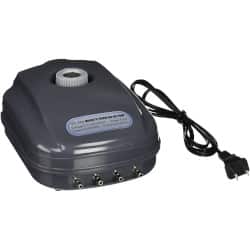
Air pump
To add oxygen to your water
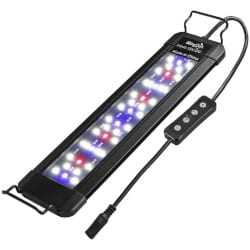
Lighting
To control the light level

Plants
For decoration & to give your fish somewhere to hide and explore
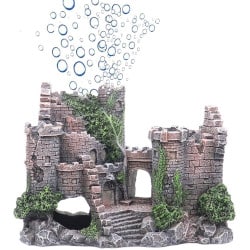
Decorations
Like plants, to look good and for your fish to hide and explore
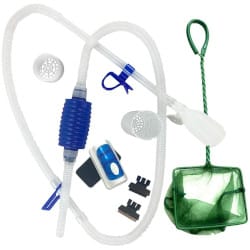
Cleaning Kit
To maintain a clean tank and perform water changes
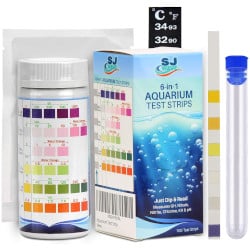
Test Kit
To measure chemical levels and maintain good water quality
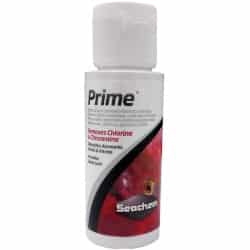
Treatments
To remove or neutralise harmful chemicals in the water
Water
To look after your goldfish, you need to look after your water. In the same way that people can’t survive long in toxic air, goldfish can’t survive long in toxic water. And there are lots of things that can pollute your tank water – from your goldfish’s poop to rotting plants or bits of uneaten food.

Looking after your goldfish water is “the science bit” of goldfish care and it can seem intimidating at first, but it’s really not too complicated. We’ll keep this simple and you can click through to more detailed articles if you’d like to learn more.
The nitrogen cycle
When setting up your tank, you need to know about something called “cycling”. And it’s nothing to do with riding a bike! It’s all about moving through the nitrogen cycle.
The nitrogen cycle is a process that turns chemicals that are harmful to your goldfish into less harmful chemicals. So it’s a good thing for your fish!
There are three chemicals you need to know about:
- Ammonia
- Nitrite
- Nitrate
Ammonia comes from your fish’s poop and other waste, such as rotting food or plants. If left unchecked in your tank, ammonia will burn your fish’s gills and fins and cause serious damage. A goldfish in a tank with lots of ammonia will not last long.
Fortunately, “good bacteria” in your water can turn ammonia into a less harmful chemical, called nitrite. Unfortunately, nitrite is still not good for your fish, so there’s one more step in the process.
That helpful good bacteria takes the nitrite and turns it into nitrate. Now, nitrate still isn’t good for your fish – so you don’t want high nitrate levels – but it’s a lot less harmful than ammonia and nitrite.
Cycling is therefore the process of building up bacteria that will turn ammonia into nitrite, and nitrite into nitrate.
To avoid harming any fish during the cycling process, you would ideally cycle your tank without fish inside. You simply need to add ammonia from a bottle to get the process started and then wait. There are also products you can buy to help speed the process along.
Water testing
But wait! How do you know how much ammonia, nitrite and nitrate is in your water? Is your water ready for your fish yet? Is your current fish living in a tank with dangerously high ammonia levels? The answer is to test your water using a test kit
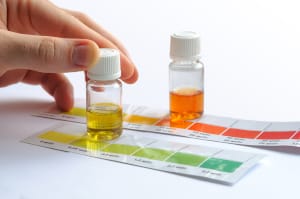
Test kits involve taking a sample of water and adding a chemical that changes its color. You then compare the color to a chart to find the level of ammonia, nitrite or nitrate. Some test kits use strips that you dip in the water and they change color instead, but the principle is the same.
Water changes
Even once your tank is cycled, waste and dangerous chemicals will build up over time. To keep your fish’s water fresh, you need a regular routine of water changes.
We recommend changing around one third of your goldfish’s water each week.
Other water parameters
We’ve talked about the chemicals in your water, but what else should a goldfish-keeper think about? There are a few more water parameters that you could consider – including pH, hardness and oxygen levels – however these tend to be ok in most tanks and goldfish are tolerant of a wide range of these parameters, so we don’t recommend worrying about them too much if you are a beginner.
There is however one other factor that you should keep a close eye on – temperature.
Goldfish like a stable water temperature within a comfortable range.
Feeding your goldfish
Managing the type and amount of food that your goldfish eats is one of the most important parts of goldfish care. Below, we look at the different types of goldfish food are available. Then, we explain how often to feed your goldfish and how much food to give them.
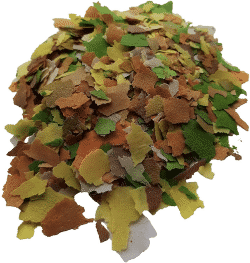
Flakes
Flakes are probably the most common type of goldfish food. However, a problem with flakes is how fast they disintegrate and pollute your fish’s water.
Goldfish may swallow air when eating flakes off the surface of the water, which can cause digestion problems.
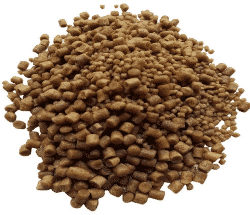
Pellets
Pellets can be purchased in sinking or floating varieties. Floating varieties have the same problem as floating flakes in that they can lead your fish to swallow air at the surface.
Pellets are very easy to store and make it easy to measure the amount you’re feeding your goldfish. Another advantage of floating pellets is that any leftovers are easy to find and remove before they rot.
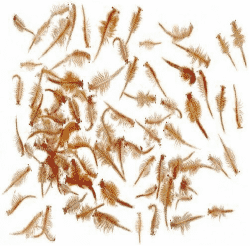
Live food
Available from most pet stores, live foods for goldfish include brine shrimp, tubifex worms, daphnia and aquarium snails.
Live foods offer a great source of protein for your goldfish. The process of catching and eating them is also closer to what your goldfish would do in the wild.
However, by purchasing live creatures from a pet store, you risk introducing disease and infections to your tank.
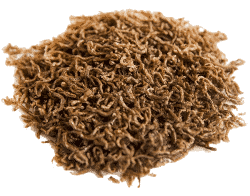
Freeze dried food
Freeze dried foods are essentially live foods (like brine shrimp) that have been frozen and had the moisture removed. This means that freeze dried goldfish foods offer lots of protein, but without the risk of disease.
We recommend including freeze dried food in any balanced goldfish diet.
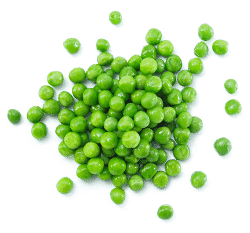
Fresh food
You don’t just have to feed fish food to your goldfish. Goldfish can eat “human food” too, including vegetables.
One of the best choices of vegetable for goldfish is peas with the shells removed. Simply boil the peas, remove the shells, then slightly mush the inside of the peas so they are small enough for your fish to eat. Peas are really great at preventing constipation in goldfish.
What should you feed your goldfish?
There are lots of different types of food goldfish can eat, but it’s not a case of choosing the “best” one. A good goldfish diet is varied, so you should choose a combination of different foods.
We recommend feeding your goldfish a healthy mix of flakes, pellets, live or freeze-dried food and vegetables. This will give them all the nutrients they need to stay healthy.
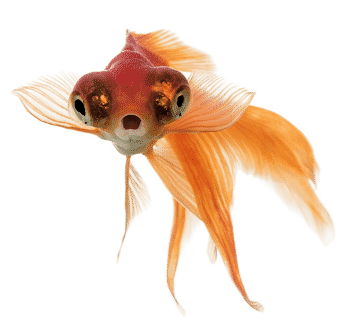
How much should you feed goldfish?
You need to be very careful not to over-feed your goldfish. Many health issues – such as constipation – can arise from giving your goldfish too much food.
So how much food should you feed to a goldfish?
Here are two common recommendations for helping you to judge the right amount of goldfish food:
- Give an amount of food equal to the size of the goldfish’s eye
- Give an amount of food that your goldfish can eat in under two minutes
If that doesn’t sound like much, well… that’s the point! Feeding your goldfish too little is almost never a problem. Whereas over-feeding can be life-threatening.
How often should you feed goldfish?
Until they are one year old, we suggest feeding your goldfish very small amounts of food 2 or 3 times per day. Once they are older than a year, you should feed goldfish just once per day.
Keep on learning…
Hopefully this introduction to goldfish care has helped you grasp the basics of what you need to be a good goldfish-keeper, but there’s lots more to learn!
We recommend exploring the links above to learn about the topics we’ve covered in more detail. It would also be a good idea to learn about goldfish diseases. Even if your fish is healthy now, knowing about the ways that goldfish can get sick can help you spot early warning signs and be prepared to treat your goldfish properly.

I have a big goldfish, ( he was a feeder goldfish/ slim goldfish), with 7 little Danios, should I get him a companion. He is in a 29 gallon tank and does a lot of swimming.
Hi Julia, thanks for commenting,
Goldfish are naturally social and do enjoy the company of their own kind, you could get another similar sized common goldfish, but be aware that you may end up needing to upgrade tank size if you add any more, as common goldfish can get quite large.
Make sure to quarantine any new fish you may add, or make sure they are healthy and not carrying disease or parasites which could be introduced to your tank.
hope this helps.
you are stiupid
Please can someone help advise me. I have 2 Oranda’s for 5 months brought as babies. They have a 60 litre tank with a bio filter. The levels are checked every day. Other than the initial start up problem with nitrates never had any issues. This morning I went to the tank to feed and test and overnight the tail on the dominant fish has been damaged it has bent in one direction on the left lupper side of his tail. I am obsessed with my fish and spend hours at the tank watching and interacting with them daily. There appears to be no other damage to either fish, not a scale out of place. Is this something I have caused, is this some rough housing gone to far. They are very affectionate together and do not fight the pecking order was established very early on. He is behaviour is exactly the same there is no change in temperament in either fish. How can I help the little fella. Thank you for any comments or questions as all are very welcome. Thank you
Hi Clare, thanks for your comment,
It doesn’t sound like you have done anything wrong.
Goldfish can be surprisingly active at night time, and sometimes if they feel irritated they can “flash”, this is a behaviour where they will quickly rub their side against a surface in order to scratch themselves,
It is possible that your goldfish could’ve done this during the night and damaged its tail.
As long as the tail does not become infected, the goldfish is otherwise healthy, and the tail causes no issue for the fish, then it is best to leave him as he is, just monitor his progress, sometimes their tails can heal and grow back.
if you suspect that the tail may be infected, Here is some information on congested fins: https://thegoldfishtank.com/goldfish-info/diseases/congested-fins-goldfish/
and here is some information on finrot:https://thegoldfishtank.com/goldfish-info/diseases/goldfish-diseases-fin-rot/
hope this helps.
helpt so much
We have enjoyed 3 Orinda gold fish for over 6 months. They have been doing well and we have been keeping up with proper maintenance. Just recently their behavior changed and they are acting sluggish and spending time on the bottom of the tank. Today for the first time they did not eat. Can you advise?
Hi Nihala,
Thank you for your comment, sluggish behaviour is a common sign that a fish is stressed or unwell.
I would recommend testing your water, fish can display stress when the nitrite or ammonia levels are too high, ph or hardness too low or oxygen levels are too low.
you may be able to take a water sample to your local fish store and they may be able to test it for you!
If the oxygen is too low, you can add an air stone to help increase aeration.
Monitor them closely and if you spot anything unusual that might look like an illness, you can use a general cure treatment or melafix to help them get back on their feet.
Here is some information that might help you identifying any illness in your fish: https://thegoldfishtank.com/category/goldfish-info/diseases/
Good luck with your Orandas, hope this helps.
What should I do? I am new to keeping goldfish. I have a 37 gallon tank and I started cycling my tank 2 weeks ago with bottled nitrifying bacteria and ammonium chloride. I read something that made me think I could cycle my tank quickly (in 15 hours). So I ordered two 3 inch orandas. They’re due to arrive tomorrow or the following day. I expect them to be stressed from the shipping. And the nitrogen cycle is not complete. I think it’s close, though. There’s no ammonia. But there’s a lot a nitrite and some nitrates. How can I make the water safe for my fish? Should I put more nitrifying bacteria in the water. Should I do a water change or add water? I have some Prime. I’m planning on putting that in the water the day my fish arrive.
Hi Penny, thanks for your comment,
An important thing to remember when you are new is not to overcomplicate things or stress too much,
the bottled nitrifying bacteria is a good product and helps to kickstart the cycle.
What has happened is you have nitrifying bacteria, but not as much de-nitrifying bacteria to complete the cycle,
I would recommend doing a 20% water change, and add a little prime, this should get your levels down a bit.
When you add your goldfish only feed them in small amounts until your nitrate levels stabilize, maybe only feed them 3 times a week to start off.
over the next few days keep a close eye on your water quality, water change or add prime in small amounts if necessary, this wont harm the cycle process much at all and will get your goldfish through the first month of the cycle process.
some good advice to a beginner is to avoid listening to advice which tells you to rush, fishkeeping requires lots of patience and the slower you take things, the easier it becomes.
Hope this helps and good luck with your orandas.
Hi! I have two goldfish at home that I just got the other day. When I was feeding them this morning, I noticed one was hogging all the food and I don’t think the other one got any. They usually swim together, so I’m not sure how hard it will be to separate them to make sure they both eat.
Thanks!
Hi Malia, thanks for your comment
A good way to make sure all the fish eat is to feed them slowly, and spread the food around the whole tank, this usually gives them the chance to get some grub.
If not, you can try feeding an algae wafer, these take a while to eat so both fish will be able to get some food.
Hope this helps 🙂
Need help on selecting new tank. I have 2 goldfish that have become quite large, probably a good 10″ and 6″. They are currently in a 20 gallon tall tank which I know is not ideal. They are at my office so I am limited a bit on size. What size do I need? Do I need a substrate filter or just a regular filter that hangs in the back. My water often smells a bit swampy and the filter doesn’t last long.
Hi Rita, thanks for your comment
A tank as large as you can fit is ideal.
For two adult goldfish, we normally say around 50 – 75 gallons is good for them to live a fairly comfortable life in.
And any type of filter is good, just get one that does the correct literate for your tank, or one that does more litres!
If you find it still gets clogged quickly, reduce your feeding, 2 goldfish should only need food 3-4 times a week.
perform 20% water changes weekly to maintain good water quality, this will stop the smell, reduce the load on the filter and keep your fish healthy.
you should only need to clean your filter once every month or so.
hope this helps 🙂
Hello!! I have 5 feeder gold fish in a 100 gallon tank they have been in it for over a year and I have recently moved them so they are no longer in the basement. is this a big enough tank I really don’t want to move them but if I have too I will. as of right now there is nothing in the tank but an air stone and the filters. I do have a 30 gallon tank if I need to move a few what are your thoughts
Thanks
Margie
Hello! I have an filter in my tank, but I was just reading about an airstone… will that be good to get for my two goldfish? They seem pretty happy, but I don’t know if they’re needing that to ensure they’re healthy.
Thank you!
Angela
i have one fantail gold fish it has 8 inches
Hello! I have an filter in my tank, but I was just reading about an airstone… will that be good to get for my two goldfish? They seem pretty happy, but I don’t know if they’re needing that to ensure they’re healthy.